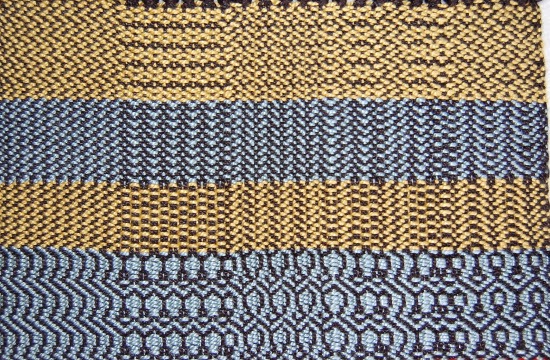By Melissa Ludden Hankens
I underestimated how exciting the process of weaving a sampler can be. Some of the tie-up and treadling combinations gave me unexpected results which gave me ideas to try out a few of the patterns on a larger scale.
- Looking at the sampler below, starting at the left, is straight twill where your twill progresses in a single direction like a set of stairs. For this example, I threaded the shafts 1,2,3,4 (or the first thread on shaft 1, the second thread on shaft 2, the third thread on shaft 3 and the fourth thread on shaft 4, and so on).
- Point twill happens when a twill weave starts in one direction, for at least three threads (according to Helene Bress), and then reverses itself. For example, here I threaded 1,2,3,4,3,2, repeat.
- A broken twill is exactly what you might expect. Instead of progressing in a sequential numerical order, backward and/or forward, a break is made in the threading so that at least one harness is skipped in the order. For this example I threaded: 3,4,1,2,4,3,2,1, repeat.
- Extended point twill is created by combining straight twill and point twill. Here I've threaded: 1,2,3,4,1,2,3,4, 3,2,1,2,3,4,3,2,3,4, repeat
- Bird’s Eye is a point twill or broken twill threading that traditionally creates a diamond pattern with a dot at its center. Here, I've threaded it: 4,3,2,3,4,1,2,3,4,3,2,1, repeat.
Each threading is approximately two inches across, give or take, using 3/2 mercerized cotton sett at 15 ends per inch. I would recommend using a dark color for your warp and a light color for your weft, or vice versa, so that you are able to clearly see the pattern you are weaving. You might also vary the warp thread color to distinguish the five threadings even further from each other – say black and charcoal or dark blue so that you still get a good contrast with your choice of weft threads. I selected two weft colors to use alternately as I went from one treadling sequence to the next. And finally, you can see that I also used a length of orange yarn to indicate where I changed my tie-up. Oh, and I came up with so many treadling sequences to try, that I ran out of white 3/2 cotton before I finished weaving. Oops!! A gold 3/2 cotton took over where the white left off.
Swatch 3
The fourth tie-up is a little bit different from the others. I got to thinking about my Wolf Pup, which is a direct tie-up loom. This means that each shaft (or harness) is attached to a single treadle. Table looms are similar in concept but use hand levers. To weave patterns that require multiple shafts to be raised at once, you press down multiple treadles or levers at one time. I got to thinking about how tying up a single shaft to a single treadle and using the direct tie-up technique of pressing down multiple treadles within the sequence might enable someone with a four-shaft loom with only four or six treadles or four levers to weave more complicated patterns. You will see the tie-up in this draft suggests that you need eight treadles. If you have them, great, but if you have fewer, simply tie-up 1-2-3-4, and when the draft indicates that you need to lift more than one shaft, use both of your feet, or hands in the case of a table loom, to accomplish this.
Draft 4
These samples showcase five common twill threadings across a single warp.
Download a ZIP file of WIFs for my sampler, including the images and weaving drafts below.
All of the samples (and drafts) are woven on the same threadings as listed above – straight, point, broken, extended point, and bird’s eye. The threading reads left to right and the treadling reads bottom to top. This will match the woven fabric in the photos.
Swatch 1


Swatch 2


Swatch 3


Swatch 4



